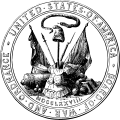Related Research Articles
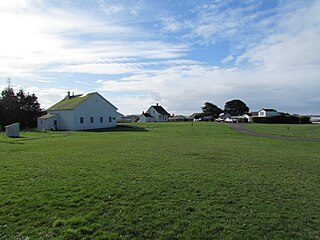
Fort Humboldt State Historic Park is a California state park, located in Eureka, California, United States. Its displays interpret the former U.S. Army fort, which was staffed from 1853–1870, the interactions between European Americans and Native Americans in roughly the same period, logging equipment and local narrow gauge railroad history of the region. Within the collection, there are trains, logging equipment, including a fully functional Steam Donkey engine, and an authentic Native American dug-out canoe. The Fort overlooks Humboldt Bay from a commanding position atop a bluff. The North Coast regional headquarters of the California State Parks system is located onsite.
The Department of the Pacific or Pacific Department was a major command (Department) of the United States Army from 1853 to 1858. It replaced the Pacific Division, and was itself replaced by the Department of California and the Department of Oregon.

California's involvement in the American Civil War included sending gold east to support the war effort, recruiting volunteer combat units to replace regular U.S. Army units sent east, in the area west of the Rocky Mountains, maintaining and building numerous camps and fortifications, suppressing secessionist activity and securing the New Mexico Territory against the Confederacy. The State of California did not send its units east, but many citizens traveled east and joined the Union Army there, some of whom became famous.
The Battle of Paducah was fought on March 25, 1864, during the American Civil War. A Confederate cavalry force led by Maj. Gen. Nathan Bedford Forrest moved into Tennessee and Kentucky to capture Union supplies. Tennessee had been occupied by Union troops since 1862. He launched a successful raid on Paducah, Kentucky, on the Ohio River.
The Pacific coast theater of the American Civil War consists of major military operations in the United States on the Pacific Ocean and in the states and Territories west of the Continental Divide. The theater was encompassed by the Department of the Pacific that included the states of California, Oregon, and Nevada, the territories of Washington, Utah, and later Idaho.
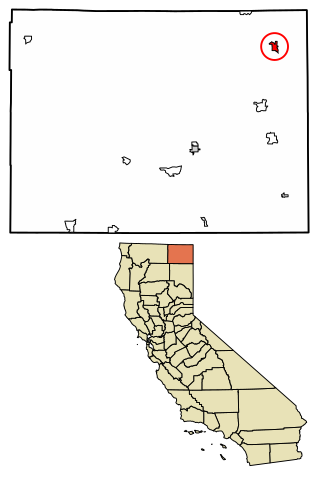
Fort Bidwell is a census-designated place in Modoc County, California. It is located 32 miles (51 km) northeast of Alturas, at an elevation of 4564 feet. Its population is 180 as of the 2020 census, up from 173 from the 2010 census.

The 1st Regiment Arkansas Volunteer Infantry (1863–1865) was an infantry regiment that served in the Union Army during the American Civil War. Although Arkansas joined the Confederate States of America in 1861, not all of its citizens supported secession. Arkansas formed some 48 infantry regiments to serve in the Confederate Army, but also formed another 11 regiments that served in the Union Army.

Iaqua is a former settlement in Humboldt County, California. It was located 5.5 miles (8.9 km) south of Kneeland.
Albeeville is a former settlement in Klamath County, now located in Humboldt County, California. Albeeville was located on Redwood Creek, within an easy day's travel from Fort Gaston. The post office was named for Joseph Porter Albee, its first postmaster, who was murdered by Indians, and the Albeeville post office burned in November 1863.
District of Arizona was a subordinate district of the Department of New Mexico territory created on August 30, 1862 and transferred to the Department of the Pacific in March 1865.

1st Battalion California Volunteer Mountaineers was an infantry battalion in the Union Army during the American Civil War. It spent its entire term of service in the western United States, attached to the Department of the Pacific. It was organized from men from the counties of Humboldt, Mendocino, Trinity, Klamath, Siskiyou, and Del Norte, and other parts of California, between May 30, 1863, and March 16, 1864, for special service in the redwood forests and mountains that was being fought over in the Bald Hills War in Humboldt County within the Humboldt Military District. The Battalion mustered out June 14, 1865.
Camp Bidwell, later Camp Chico, was a U.S. Army post during the American Civil War. Camp Bidwell was named for John Bidwell, the founder of the nearby town of Chico, California, and a brigadier general of the California Militia. It was established a mile outside Chico, by Lt. Col. Ambrose E. Hooker with Company A, 6th California Infantry, on August 26, 1863. Although a Company F, 2nd California Cavalry and Company K, 2nd California Infantry under Captain Augustus W. Starr had been there from July 31, 1863, Lt. Col. Hooker moved the camp to a new location for its better defense and for better sanitation.
Fort Wright, was an Army post located in the Round Valley of Mendocino County, about 1.5 miles (2.4 km) s northwest of the present town of Covelo, California. The principal duty of the garrison was to protect the Round Valley Indian Reservation's Indians from the intrusions, thefts and attacks of white settlers. From 1858, Federal troops had garrisoned the Round Valley Reservation until they were sent east in late 1861.

Bald Hills War (1858–1864) was a war fought by the forces of the California Militia, California Volunteers and soldiers of the U.S. Army against the Chilula, Lassik, Hupa, Mattole, Nongatl, Sinkyone, Tsnungwe, Wailaki, Whilkut and Wiyot Native American peoples.

Camp Curtis, California State Historic Landmark #215, was located about one mile north of Arcata, California, and served as the headquarters and garrison of the 1st Battalion California Volunteer Mountaineers from 1862 to 1865.
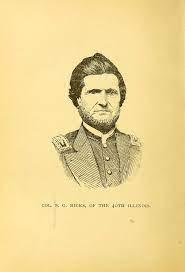
Stephen G. Hicks was an American soldier [Half Cherokee Indian], born in Jackson County, Georgia. His father, John Hicks, was one of the seven soldiers killed in action at the Battle of New Orleans. Stephen Hicks served in the army during the Black Hawk War, Mexican War and Civil War.
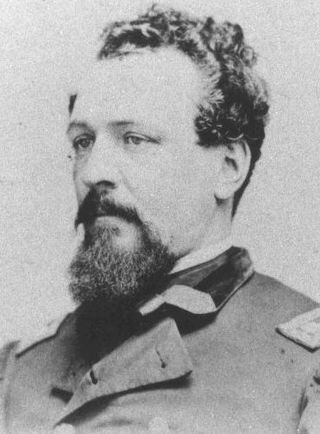
James Gwyn was an officer in the Union Army during the American Civil War. He immigrated at a young age from Ireland in 1846, initially working as a storekeeper in Philadelphia and later as a clerk in New York City. At the onset of the war, in 1861, he enlisted and was commissioned as a captain with the 23rd Pennsylvania Volunteer Infantry. He assumed command of the 118th Pennsylvania Regiment in the course of the war. Gwyn led that regiment through many of its 39 recorded battles, including engagements at Seven Pines, Fredericksburg, Shepherdstown, Five Forks, Gettysburg, and Appomattox Court House.

Fort Baker, in Humboldt County, California was an outpost of the Union Army for the Bald Hills War from 1862 to 1863. It was located 14 miles (23 km) east of Bridgeville on State Highway 36 on the west bank of Van Duzen Creek in Larabee Valley. The site of Fort Baker has been obliterated by frequent flooding.
San Augustin Spring, formerly also known as San Augustine Springs, is a spring in the Organ Mountains in Doña Ana County, New Mexico. It lies on the east side of San Augustin Pass at an elevation of 5627 feet / 1715 meters, 14.7 miles east northeast of Las Cruces, New Mexico.
Paraje was a populated place along the east bank of the Rio Grande, in Socorro County, New Mexico, United States, now a ghost town. It is located north northeast of the Fra Cristobal Range.
References
- ↑ Eicher, John H., David J. Eicher, Civil War High Commands, Stanford University Press, 2001, ISBN, retrieved February 22, 2013.
- ↑ Military Division of the United States After The Civil War, General Orders No. 118., Washington, June 27, 1865, retrieved February 22, 2013.
- ↑ Strobridge, William F. (1994). Regulars in the Redwoods: The U.S. Army in Northern California, 1852-1861. Arthur H. Clarke Company. pp. 255–257. ISBN 0-87062-214-5.
- ↑ "Fort Bragg". Office of Historic Preservation, California State Parks. Retrieved 2012-10-09.
- ↑ "Del Norte". California Historical Landmarks. Office of Historic Preservation. Retrieved 2005-08-29.
- 1 2 3 Scott, Robert N., H. M. Lazelle, George B. Davis, Leslie J. Perry, Joseph W. Kirkley, The War of the Rebellion: a compilation of the official records of the Union and Confederate armies, Misc. doc. (United States. Congress. House); United States congressional serial set. Series I, Volume L. Part I, p. 77-78, 82-83, 84, 256, 270-271, 1008, 1054, 1108, Govt. Print. Office, Washington, D.C. , 1880-1901. retrieved February 22, 2013.
- ↑ Bledsoe, Anthony Jennings, Indian wars of the Northwest: A California sketch, Bacon and Co., San Francisco, 1885, pp. 233-237
- ↑ Hart, Herbert M., Historic California Posts: Fort Gaston(Camp Gaston) (Humboldt County), in Pioneer Forts of the Far West, 1965, The California State Military Museum
- ↑ Historic California Posts:Fort Seward (Camp on the Eel River), The California State Military Museum.
- ↑ Scott, Robert N., H. M. Lazelle, George B. Davis, Leslie J. Perry, Joseph W. Kirkley, The War of the Rebellion: a compilation of the official records of the Union and Confederate armies. Misc. doc. (United States. Congress. House); United States congressional serial set. pp. 161-164, 168-170, 175-176, 184-185, 202-203, 205, 218-219, 221-222, 229-231, 237-238, 248, 250-251, 261-264, 282-283, 300-301, 304-305, 408, 473-474, 481-482, 562-563, 633-636, 661, 662, 717-718, 950-951, 963, 984-985, 1161]
- ↑ Hart, Herbert M., Historic California Posts: Fort Anderson (Camp Anderson), The California State Military Museum, accessed February 12, 2012]
- ↑ Historic California Posts: Fort Baker
- ↑ Historic California Posts: Camp Liscom Hill (Fort Liscom)
- 1 2 Scott, Robert N., H. M. Lazelle, George B. Davis, Leslie J. Perry, Joseph W. Kirkley, The War of the Rebellion: a compilation of the official records of the Union and Confederate armies. Misc. doc. (United States. Congress. House); United States congressional serial set. Series I, Volume L. Part I, p. 972
- ↑ Scott, Robert N., H. M. Lazelle, George B. Davis, Leslie J. Perry, Joseph W. Kirkley, The War of the Rebellion: a compilation of the official records of the Union and Confederate armies. Misc. doc. (United States. Congress. House); United States congressional serial set. Series I, Volume L. Part I, p. 68
- ↑ Historic California Posts: Elk Camp, The California State Military Museum,
- ↑ Historic California Posts: Reed's Ranch Post, The California State Military Museum
- ↑ Historic California Posts: Camp Olney, The California State Military Museum
- ↑ Hart, Herbert M., Historic California Posts: Fort Iaqua (Camp Jaqua, Camp Iaqua), from Pioneer Forts of the Far West, 1965, The California State Military Museum
- ↑ Historic California Posts: Gold Bluffs Post, The California State Military Museum
- ↑ Historic California Posts: Camp Gilmore, The California State Military Museum
- ↑ Historic California Posts: Camp at the Forks of the Salmon, The California State Military Museum
- ↑ Historic California Posts: Camp at Martin's Ferry, The California State Military Museum
- ↑ Historic California Posts: Camp Boynton Prairie, The California State Military Museum
- ↑ Historic California Posts: Camp Burnt Ranch, The California State Military Museum
- ↑ Historic California Posts: Camp Mattole, The California State Military Museum
